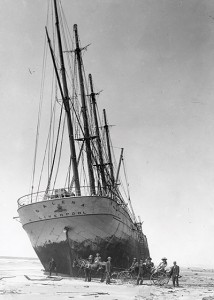 Words: Peter Marsh
Words: Peter Marsh
Whether you visit the mouth of the Columbia River by boat or live here as I do, you can’t avoid the constant reminder that the Columbia Bar is the “Graveyard of the Pacific—the most treacherous stretch of water in the world,” or words to that effect. Exactly who decided this (or that a river is capable of treachery) has been lost in the sands of time, like most of the wrecks. It certainly has a good ring to it and is regularly quoted in publications from the New York Times to Sunset magazine.
This does fit rather well with other local spots with depressing names like Cape Disappointment (from George Vancouver) and Dismal Nitch (from Lewis & Clark). As if that isn’t gloomy enough, it’s always backed up by an impressive statistic of “2,000 vessels and 700 lives lost.” This sounds very official and is quoted as the ultimate proof that we are number one in the shipwreck stakes. It’s a title that is a real point of pride among local residents.
I hate to spoil things, but that number of 2,000 has always sounded suspiciously high and conveniently round, especially when compared to the loss of life. Only one death for every three wrecks? Remember the North Pacific is cold, and many wrecks occurred when most people couldn’t swim, and before inventions like lifejackets, rafts, radios, etc.
So I decided to dig a little deeper into these dangerous waters and found several authoritative books with lists of wrecks. James Gibbs was a nautical expert and unofficial coastal historian after WWII, and he wrote many books about sailing ships and wrecks including Pacific Graveyards (1964). He counted 205 ships wrecked near the mouth of the Columbia with 45 of them re-floated. Don Marshall, author of the book Oregon Shipwrecks (1984), only added a handful to that total.
In 2006, local entrepreneur and publisher Bill Brooks made an exhaustive inquiry for his “ultimate” wreck map. Using databases and archives, Brooks dredged up over 300 ships wrecked, plus about 100 fishing boats, and managed to list them all on the map that he distributed in a framed limited edition. That looks like more than enough nautical disasters to me, although I recently heard a lecture by local historian and wreck diver Jerry Ostermiller who suggested the number of wrecks could exceed 3,000! So take your pick…
The Fine Line Between Life and Death
Regardless of the total number, the vast majority of wrecks happened in the days of sail. Before any modern inventions that aided navigation or rescue, if the ship made landfall on “a dark and stormy night,” it could easily disappear without a trace and take the entire crew down with it. That was the fate of many a proud ship, but a sailing ship was just as likely to wreck in calm as in a storm.
When the vessel drifted helplessly onto the shore on a windless day, the crew had a good chance of survival. With many miles of sandy beach around the Columbia, they might even be able to walk ashore. Their fate depended on the tide: was it rising or falling? If a heavily laden ship grounded with a big swell, a rising tide could sweep the decks. But if the tide was falling, the ship could be high and dry in a few hours.
If you could hold on long enough, there was also the chance of rescue by the U.S. Lifesaving Service (USLS), who were stationed at Cape Disappointment, Washington at the mouth of the Columbia, and at Point Adams on the Oregon side. Until 1915, they were only equipped with a single 26’ rowboat to reach any survivors. If the wreck was to the north along the Washington shore, the lifesaving crew could telegraph the railway depot, before hauling their half-ton boat on its trailer to the railroad track nearby, and load it onto the next train.
The USLS rode the rails as close to the wreck as possible and dragged the boat onto the beach—a method that left a lot to be desired if you were hanging on in the rigging! It wasn’t much better on the Oregon shore, where they harnessed their draft horses and hauled the boat through the dunes before then trying to launch into the surf. In either case, the public often managed to show up in time to watch the rescue.
So a great many sailors did live to tell the tale, and their ships survived long enough to be photographed by the cameramen of the day. These photos, the ones we see in the history books, are the images I have chosen for this story. Ironically, the worse the wreck, the less information there is. If there were no survivors and no wreckage, there were no stories and no photos, just a formal report from the official inquiry.
The World’s Most Photographed Wreck
If it’s not the most photographed wreck in the world, the 287’ four-masted barque Peter Iredale is certainly the most photographed on the West Coast. Barely a day goes by even in winter without someone visiting the rusty remains on Clatsop Beach, about four miles south of the river’s mouth, in Fort Stevens State Park in northwest Oregon. It’s been the center of attention for 110 years after a peaceful wreck that author Don Marshall artfully described as “the most singularly unexciting shipwreck in maritime history.” It’s not hard to take a great photo here.